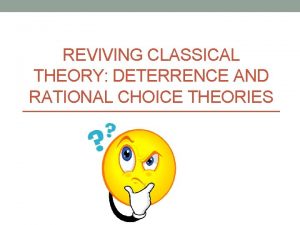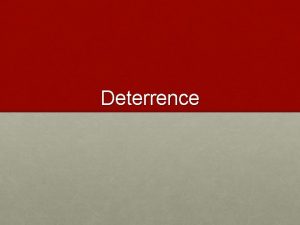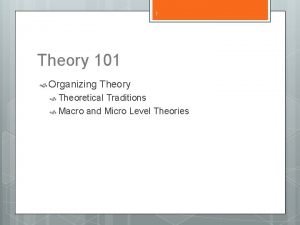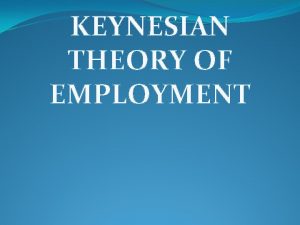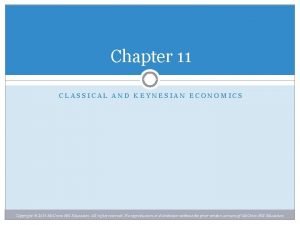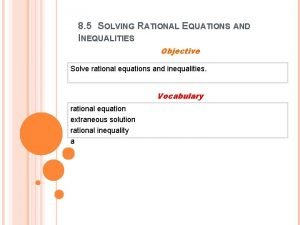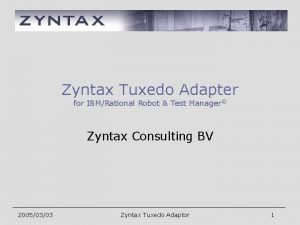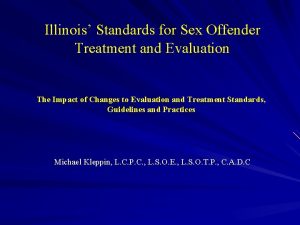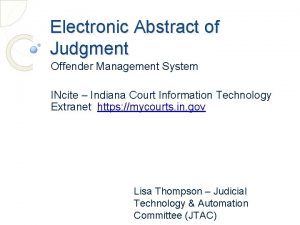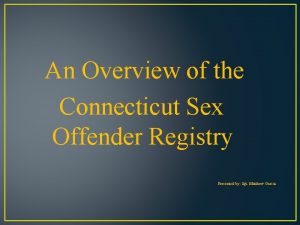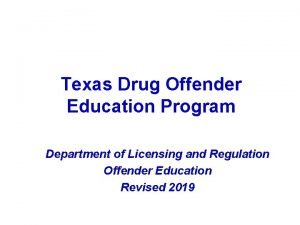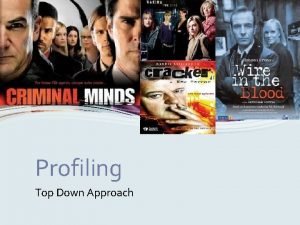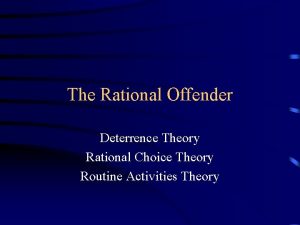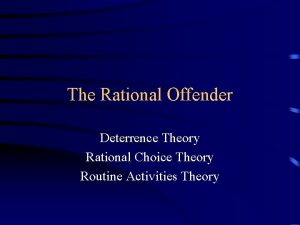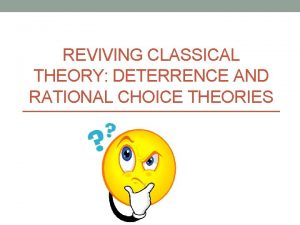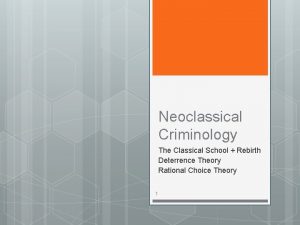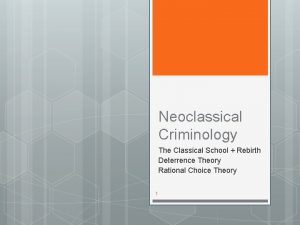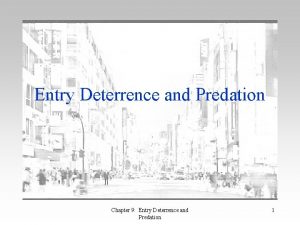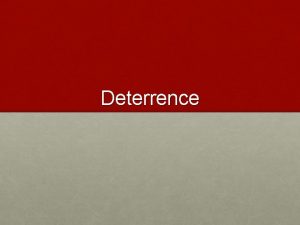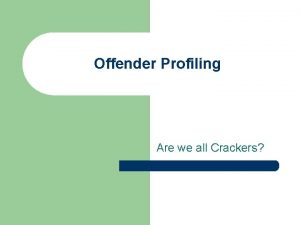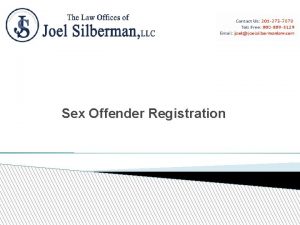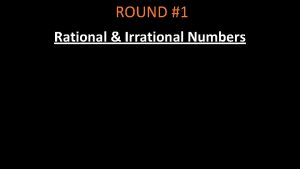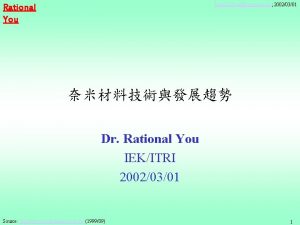The Rational Offender The Classical School Deterrence Theory





















- Slides: 21

The Rational Offender The “Classical School” Deterrence Theory Rational Choice Theory Routine Activities Theory

Social Context of the “Classical” School n Prior to the 1700 s q n “The devil made me do it” Punishments/justice system?

Social Context II n Classical School Criminology (1700 s-1800 s) q n Bentham, Beccaria, others rail against an “inhumane” justice system Along the way, they articule a “general theory” of human behavior q Borrow heavily from Thomas Hobbes

Becarria n An Essay on Crimes and Punishment (1764) q On the origin of punishment (Hobbes) n n q What is the nature of human beings? “War of all against all” What should be done to the system of laws? n n Interpretation of Laws Obscurity of Laws

Beccaria II n What is the purpose of punishment? q n “Prevent the criminal from doing further injury to society, and to prevent others from committing the like offense. ” Necessary conditions for this? q q q Proportion between crimes and punishment Advantage of immediate punishment Certainty more important than severity

The Classical School Fades n n By the early 1900 s, most dismissed this as a valid theory of criminal behavior What emerged is called the “Positive school” q q q n Changes in legal system didn’t lower crime rates “Armchair theorizing” questioned Humans as “determined” rather than “rational” From early 1900 s until the 1970 s, the positive school was unchallenged q Sociology was dominant force (search for root cause)

Rebirth of Deterrence n n Social Context of U. S. in the 1970 s James Q Wilson, Thinking About Crime q n Martinson q n “Nothing Works” in rehabilitation Murray q n There are no “root causes of crime” “Punishment Programs” rather than rehab programs Economists enter Criminology q Becker’s “Rational Choice” article

Current Neo-classical Theories n Deterrence theory q q n Rational Choice theory q q n Swift, certain, severe punishment reduces crime Focus on formal punishment Focus on how rational offender is The “flip-side” of deterrence Routine activity theory

Deterrence Theory Assumptions 1. Humans are Rational (cost/benefit) 2. Humans are self-interested and hedonistic 3. Human behavior can be controlled through certain, swift, severe punishment

Deterrence Theory n Criminal behavior (or crime rates) vary directly with _______ of FORMAL punishment. q q q n n Certainty Severity Swiftness MICRO or MACRO? Specific or General

Marginal versus Absolute n Absolute deterrence: the existence of formal punishment reduces crime n Marginal: increases in existing formal punishment reduces crime further

General Deterrence (Macro) n n What should reduce crime rates? Evidence: q Severity of Punishment n q Certainty of Punishment n q Death Penalty Research Experiments in Certainty (KC patrol) Swiftness of Punishment?

General Deterrence Micro Level n An individuals perceptions of _______ influence their decision to commit crimes. q n “Perceptual Deterrence” Criticism of “objective” = do people really know the clearance rate? q Better: what do you think the clearance rate is?

Perceptual Deterrence Research Initial cross sectional studies: Perceived risk, severity SR crime n q q But, what is the causal order? ? “Experiential” effect SR crime n perceptions or certainty/risk Manipulation of Perceived Risk q Scared Straight

Specific Deterrence n A person who commits a crime and is punished is less likely to commit additional crimes. q n Swift, Certain, Severe (Marginal) How test these propositions?

Testing Specific Deterrence n Prison vs. Probation? q n Perhaps, “time in prison” or “type of prison” More realistically q q q Probation vs. Intensive Probation vs. Boot Camp Sherriff Joe’s pink underwear tent camp study

Larry Sherman’s Domestic Violence Experiments q Random assignment of police response to D. V. n n n q Counsel Separate Arrest Minneapolis results = very positive (arrest decreases crime) n n Leads to “Mandatory Arrest” BUT….

Sherman Experiments II n Replication in Milwaukee q q q Arrest increases future D. V. Re-analysis of data—different effects depending upon whether individuals were employed Similar results from other D. V. experiments n WHY? Formal Sanctions may “Activate” Informal Sanctions (fear of job loss, fear of disapproval)

Deterrence Review: n Deals only with formal legal sanctions. q q n Is this fair? Classical school roots, policy implications Empirical Support? q General Deterrence n n q Macro Micro (Perceptual) Specific Deterrence

Why little support for deterrence? n n We can’t get certain, severe, swift enough The theory is based on bad assumptions q q n How rational are we? Equality of opportunity, pleasure, pain? “Marginal” deterrence

POLICY IMPLICATIONS n n n General Deterrence: certain, swift, and severe punishment reduces crime rates, or the probability that an individual will offend Specific Deterrence: CS&S punishment reduces recidivism Can’t/Won’t make sentences swift, certain, and severe enough? q Incapacitate
 Specific deterrence
Specific deterrence Once a sex offender always a sex offender
Once a sex offender always a sex offender Specific deterrence
Specific deterrence Specific deterrence
Specific deterrence Identity theft law
Identity theft law Difference between classical theory and neoclassical theory
Difference between classical theory and neoclassical theory Explain the keynesian theory of employment
Explain the keynesian theory of employment Three ranges of the as curve
Three ranges of the as curve 8-5 solving rational equations and inequalities
8-5 solving rational equations and inequalities Ibm rational robot
Ibm rational robot Prashant chopra sex offender
Prashant chopra sex offender Sex offender evaluation illinois
Sex offender evaluation illinois Incite indiana court
Incite indiana court What are the 8 criminogenic needs
What are the 8 criminogenic needs Offender workforce development specialist
Offender workforce development specialist Connecticut sex offender registry
Connecticut sex offender registry Thor approved rehab ga
Thor approved rehab ga Texas drug offender education program test answers
Texas drug offender education program test answers Sarah skett
Sarah skett An exploder offender:
An exploder offender: Yakama nation sex offender registry
Yakama nation sex offender registry Top down profiling
Top down profiling
